It has become a Thanksgiving tradition, just like turkey,
cranberries and too many relatives. The National Dog Show
presented by Purina airs annually on the holiday, right after
the Macy's Thanksgiving Day Parade. After all, what is
there to be more thankful for than man's best friend?
Our hosts and guides to the show, which is filmed annually at the
Philadelphia Kennel Club's annual event, are a mix of Hollywood
suave and dog-world smarts. The suave, silver-tongued John
O'Hurley is a TV icon best known for playing Elaine Benes' eccentric
boss on the legendary sitcom Seinfeld, as well as winning
Dancing With the Stars in 2005. His co-host David
Frei is normally a more behind-the-scenes type, an American Kennel
Club-licensed judge who also hosts The Westminster Kennel Club
Dog Show when not busy working with therapy dogs and as an
ambassador to the canine breeding world.
We were recently able to speak with O'Hurley and Frei on a
conference call with a few other sites about the 12th annual airing
of The National Dog Show.
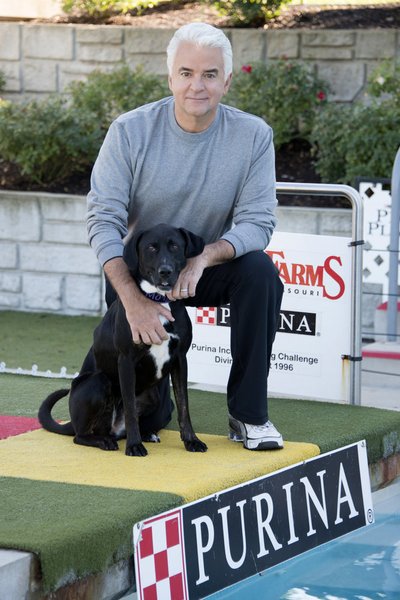 W.C.
Fields said to never work with children or animals because they
always can steal the spotlight from you. Obviously these are trained
dogs, but they are still dogs. What are some of the funniest or
cutest unplanned things that have happened at the shows over the
years?
W.C.
Fields said to never work with children or animals because they
always can steal the spotlight from you. Obviously these are trained
dogs, but they are still dogs. What are some of the funniest or
cutest unplanned things that have happened at the shows over the
years?
John O’Hurley:
Well, I’ll pipe in there because I remember several years in, David
and I were seated there at the NBC booth. During the group
competition, the Great Dane came in and just passed David at the NBC
booth. Then [he] just stopped right in front of me and squatted down
and left what I will refer to as a “critical donation on my
performance.” Yes, that was probably the largest and most
significant.
Did you have
one, David?
David Frei:
Well, I think mine is more of a general nature. I always talk about
these dogs as being real dogs shown in dog shows by real people. So
they’re just like your dogs at home. They’re not just show dogs that
sit around on doggie cushions eating doggie bon-bons all week long.
They do all those things at home that your dog does. They shed on
our black clothes and steal food off the counters. They even drink
out of the toilet once in a while.
When they come to
a dog show they just continue to do those cute things; whether it’s
going over to the edge of the ring and jumping up to say hello to
the fans, or have some child pet them and interact with them, or if
they’re interacting with another dog in the ring and playing. I
think that’s something that we try to show people, that they’re just
like your dogs at home. They just dress up on weekends and go to dog
shows, but other than that they’re real dogs.
Now, John, I
can’t talk to you without mentioning Mr. Peterman, which is such a
beloved character. How did you get involved with
Seinfeld, and what was it like to work on such an iconic series?
John O’Hurley:
Well, Seinfeld literally was just an absolutely happenchance
moment. The series that I had on ABC was cancelled on a Thursday
morning. I was out, literally, crying in my beer that night trying
to take the cancellation as personally as I possibly could. Then,
David’s office called and just said they had this guest star on the
next [episode]. They were starting the next day. They knew that my
show was cancelled. So, they said, “Would you like to come over and
do it? It’s this, kind of, wacky cataloguer named J. Peterman.”
Originally I said no. My manager called me the following morning and
said, “Oh, just get up and go have fun. Blow the series out of your
system.” That’s what happened. (laughs) But originally I said
no to it.
They hadn’t even
completed the episode and by the end of the week they had written in
that Elaine was then working for the J. Peterman catalogue. That
began the last four seasons of my venue there on Seinfeld. As
I look back over my shoulder at it, I remember it was kind of like
playing with a championship team in the championship season. You
always had a sense that what you’re doing was something that was
going to be part of television history.
David Frei:
I always have great fun with John. We’ll be sitting there, we’ll be
talking, we’re looking into the ring, and John will say something.
I’ll say: That wasn’t John. That was J. Peterman. Where’s Jerry?
Where’s Elaine? Where will be Kramer? Where are these people? So
that character is still evoked by a lot of the things that he says
and does. I think that’s great fun for all of us.
John O’Hurley:
I still add a few Peterman-isms in.
David Frei:
Goes back to your W.C. Fields quote about working with children and
animals and working with John O’Hurley.
John O’Hurley:
Much tougher.
David Frei:
He introduced me somewhere the other night and made some great
speech introducing me. I said: Oh my God, how am I going to follow
that? I thought – you know, it’s just like standing next to him on
television. He’s 6’3”, great hair, lean and beautiful. Here I am,
some little guy in a tux. (laughs) It’s great fun to be with
him, but it’s a constant challenge to be on top of everything.
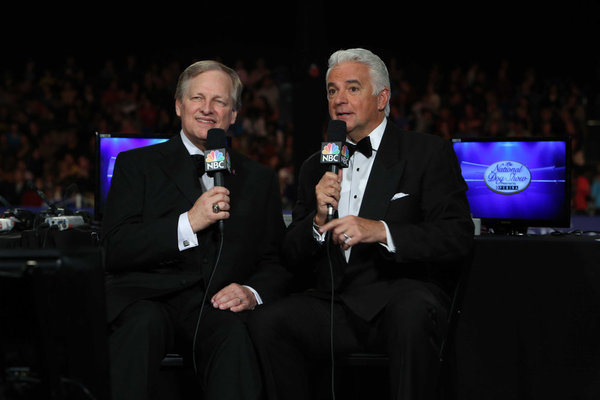 Clue
us in on just some of the ones to watch this year.
Clue
us in on just some of the ones to watch this year.
John O’Hurley:
Well, I’ll begin. Before David speaks, I’m going to cover it and say
that this was the first time – and I remarked about this to David –
this is the first time he’s not been able to point me towards a
potential winner. Because we had so many great dogs this year. It’s
an absolute, incredible line-up that we have this year. Even David,
even someone that’s able to pierce the veil and see who’s good and
who’s not, was not able to come up with even three or four that he
could name, because there were so many.
David Frei:
It’s always fun at the dog show because we don’t always know who’s
entered as we get there. I think the top dog in the group entered in
four different groups, so top ten dogs all over the place. But not
really any one that you can look at and say, “This is the one that’s
going to win; he’s winning everything.” All these dogs have been
winning all year long in different places. This is one of the rare
times where they’re all in the same place at the same time. So, yes,
there are dogs to watch, eventually, as we got to it, but going in
it was wide open. We had fun getting to that point at the end.
John O’Hurley:
David, I think you’ll agree with me when I say that this was some of
the most exciting group competitions we’ve had in the twelve years.
David Frei:
It seems like every time that we sat there and looked at the final
line-up – or even the beginning line-up in the group after our
camera had done its walk-by of every single dog in the group –
saying, “Oh my God. This is a tough group. You’re going to need to
have more than four ribbons.” That’s exactly the way it was all day
long.
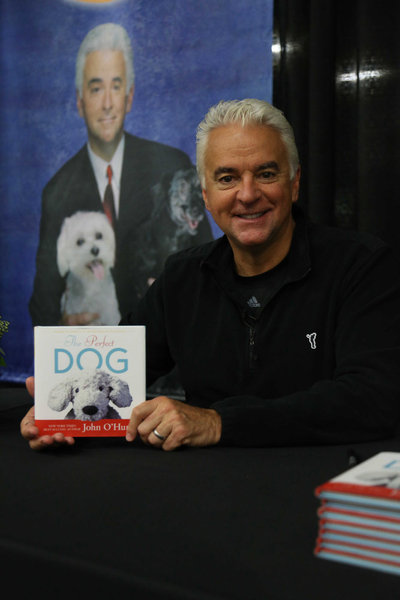 John,
you’ve been involved with
The National Dog
Show presented by Purina since it had started, and you’ve come
out with a number of books – a fantastic one recently. Can you tell
us a little bit about, not only that book, but what has your
involvement in The National Dog Show meant to you? How has it
grown within your family, and your feelings toward the dogs?
John,
you’ve been involved with
The National Dog
Show presented by Purina since it had started, and you’ve come
out with a number of books – a fantastic one recently. Can you tell
us a little bit about, not only that book, but what has your
involvement in The National Dog Show meant to you? How has it
grown within your family, and your feelings toward the dogs?
John O’Hurley:
That’s a really wonderful question. Let me begin by talking about
the books. I never write from the perspective being an expert, it’s
just from a person who’s observing life as I have. I write from an
observational standpoint and also an autobiographical standpoint.
Just the way the dogs have affected me – the first book that I wrote
was called It’s Okay to Miss the Bed on the First Jump and
the Other Life Lessons I’ve Learned from My Dogs. Just
essentially, I have grown in my sensitivity to what dogs really
bring to our lives. A lot of that has been by education with David
here. I just took as many observations on how dogs truly teach us
extraordinary life lessons, if we’re quiet enough to observe them.
There are great messages there for everybody to absorb.
I followed it up
with another book that was really just a lesson. The second book is
really a letter to my son and little lessons on manhood that were
written by my oldest Maltese, who totally distrusted that I’d ever
be able to teach my newborn son anything on the subject of manhood.
So, he wanted the first shot across the bow.
This last book
that came out last week, was really, once again, a poem for my young
son. It was about the idea of the perfect dog. It’s been something
that underscores what we have maintained as a philosophy in the show
– that as much as we support the idea of excellence in breeding and
support the rich history of breeding through the dog show, that we,
by no means, ever mean to say that the best in show is the best dog.
It is not the perfect dog. The perfect dog, really, is the one home
sitting next to your on the couch. That’s really the idea of what
the book was. I think it kind of embodies the nature of what we’re
trying to show on The National Dog Show presented by Purina.
David, you’ve
been involved with dogs in one way, shape, or form, pretty much your
whole life. You are with the Westminster Dog Show,
the National Dog
Show presented by Purina, and those types of things. You’re a
handler, a breeder, a judge for many years. Can you talk a little
bit about how you started getting involved in therapy dogs, Angel on
a Leash?
David Frei:
Sure,
I’m always happy to talk about our therapy dog involvement. Angel on
a Leash was a charitable activity that I started for the Westminster
Kennel Club in 2004, visiting at the Morgan Stanley Children’s
Hospital in New York City, and then at the Ronald McDonald House in
New York City. It grew so quickly that we made it into its own
501C3. It’s an independent charity now, which I’m still president
and founder of. We create and administer therapy dog programs in
healthcare facilities all over the country. We’re very excited about
the great work that our dogs do in all these places.
It was inspired,
originally, about fifteen years ago when I met my wife Cheri. [She]
had just gone back to school to get her Master’s Degree in Theology
– to go with her Master’s Degree in Chemistry, by the way. She was
interested in therapy dogs, She heard me mention it on the
Westminster telecast one year. [Cheri] asked a mutual friend of ours
in the dog show world and from my restaurant that I owned to
introduce us so we could talk about therapy dogs. And, as they would
say on Seinfeld, “Yadda, yadda yadda.”
Now we’re married
and doing wonderful things together with therapy dogs for people in
need everywhere. Cheri’s a Catholic chaplain and Director of Family
Support at the Ronald McDonald House, where our dogs visit every
week. We get the ultimate comment with our dogs when a parent says
to us, “That’s the first time that my child has smiled all week.”
Those are the great things that our dogs do. We like our dog show –
The National Dog Show presented by Purina – to be a
celebration of the dogs in our lives. As John says, the real best in
show dog is the one that’s sitting on the couch next to you at home.
We hope that the joy that John and I have from our own dogs and from
being involved in the show comes across for everybody.
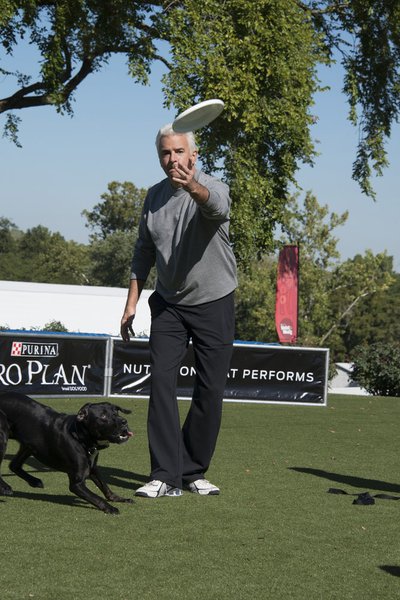 Do
any of the breeds that we will be seeing on the show on Thanksgiving
Day have the ability to be a service dog, or a therapy dog?
Do
any of the breeds that we will be seeing on the show on Thanksgiving
Day have the ability to be a service dog, or a therapy dog?
David Frei:
Absolutely. I say that great therapy dogs are born, not made.
Really, when we’re doing the training for therapy dogs, the training
really is for the person more so than the dog. The dogs have to have
the right personality and temperament. It doesn’t matter what breed
they are and it doesn’t matter if they’re a mixed breed, as long as
they have the right kind of temperament and personality. As for a
service dog, any breed can be a service dog, There’s so many
different things for service dogs to do that any breed can do those
with good training.
David, I have
something specific to ask about. Where are the dogs housed during
the show? There are so many of them. What accommodations are made
for them?
David Frei:
Well, a lot of people drive in for the day. There are a number of
them living in the area. There are a number of people who come in
motorhomes, There’s accommodations for that in the parking lot.
Also, a lot of the area hotels make special exceptions sometimes to
their rules, or they just allow dogs to be there.
It really is a
community event at that level that the community is fully behind.
They’re excited to have the dog show. All those people and tourists
and the people who spend money at restaurants and at the
world-famous mall there at Valley Forge/King of Prussia. So, they’re
happy to have us there. I know they’re happy to have me and my wife
there, doing our show.
Well, do you
know anything specific about what they do for the dogs? Do they have
to bring in anything special as far as food goes? Or any other
amenities?
David Frei:
No, I think people who come to dog shows are always prepared to be
the full supplier for being on the road with their dogs. They
generally will crate them. They will always crate them when they’re
in hotel rooms. They bring their own food. It’s just like taking
your family on the road.
John O’Hurley:
Also, just to put an addendum in there as well - because it’s a
bench show, of course all the dogs remain backstage there within
their crates and in their little areas. Their benched areas so that
they’re primping and preening, of course. But it also gives the
15,000 or so people that show up to the expo center there a chance
to walk up and down the aisles and ask questions of the breeders and
owners, as well.
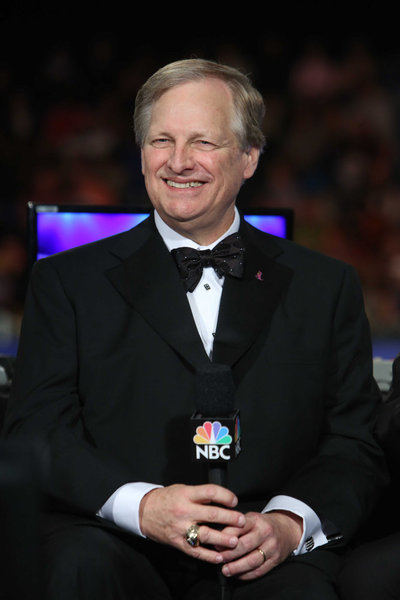 What
are some of the tricks – behind the scenes or in front of the scenes
– that handlers use to present their dog to the judges to the best
of that dog’s ability?
What
are some of the tricks – behind the scenes or in front of the scenes
– that handlers use to present their dog to the judges to the best
of that dog’s ability?
David Frei:
Well,
the thing that everybody needs to remember is that these dogs – we
see them for two minutes in front of the judges. It’s often a
lifetime of training and conditioning and hard work to get them
ready to be there for those two minutes. So, I think the trick is to
make sure that your dog is always paying attention to you, the
handler.
Then, at the same
time, we say that the best handlers are invisible; so, they have to
be able to present the dog in a way that draws attention to the dog,
rather than the handler. I think, in terms of tricks, that’s the
main thing. Make sure that they’re focused on you and that they’re
having a good time. If the dog’s not enjoying it, and/or you’re not
enjoying it, you’re not going to enjoy it as a team and you’re not
going to be effective in the ring. You’re just not going to look
right. John, you’ve seen those guys...
John O’Hurley:
That’s a very good point. I would say that attention is probably the
most [important thing]. I also think that not only attention, but
tension. The relaxation factor. A handler brings a sense of ease to
make the dog look their best. You see the dogs that just have a
natural sense of flow. Yet, we do see handlers from time to time
that are not comfortable in themselves and that communicates down
the leash to the dog, as well. David, would you point that out? I
think we’ve seen a couple of times down on the floor where you’re
just looking at somebody that doesn’t look like they’re comfortable
with the dog, and the dog doesn’t have that sense of spark, because
they pick up everything unconsciously.
David Frei:
Perfectly said, John. You’re absolutely right. It’s a team. That
leash goes back and forth. If the dog’s having a tough time, the
handler’s going to feel it, as well. But mostly, if the handler’s
nervous and excitable, then the dog’s going to feel that down the
leash and it’s just not going to work.
If the dog
does get too excited and maybe they jump at or even make contact
with a judge – they’re not disqualified for that, it doesn’t appear.
David Frei:
Well, they’re not disqualified, but, the dog needs to be under
control so that they can be showing with the help of the handler
their strong points to the judge. If they’re going to jump up on the
judge or move too fast, the judge isn’t going to have the time to
evaluate, good or bad, what they have to share with the judge.
John O’Hurley:
It goes back to what David underscores each year. The written
specifications for each breed are different and specific. The dog
really needs to be judged against that specification. In many cases
– in all cases – it really begins with control, so the dog can show
itself off at the best of their ability.
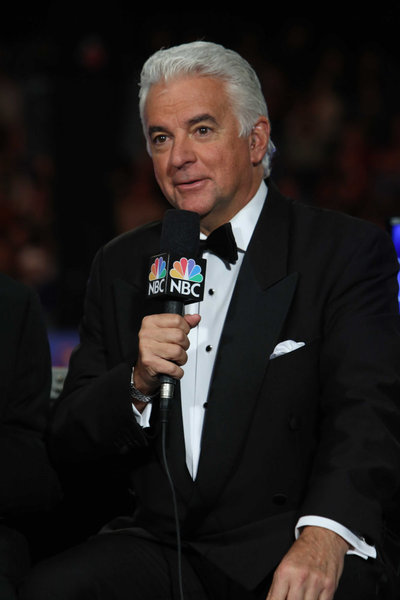 Do
you happen to know what is the youngest dog that may be competing in
this particular event?
Do
you happen to know what is the youngest dog that may be competing in
this particular event?
David Frei:
Well, it’s probably around six months, because that’s the youngest
they can be to be eligible. For a show like the Kennel Club of
Philadelphia, where the entry deadline is two weeks-two and a half
weeks before the show, there are probably some dogs that are six and
a half months old and are being shown for the first time.
That’s a lot
to contend with for a newbie.
David Frei:
(chuckles) Well, they’ve got to start sometime.
John O’Hurley:
Yes exactly, but it is apparent – and from my unschooled eyes now –
you can see a dog that is operating from its youth rather than its
experience.
Well said.
That sounds like the underlying of a book.
David Frei:
That’s my partner. That’s my partner saying those things. I’m so
proud.
John O’Hurley:
There you go. There’s another book. We’re starting a new book.
I had a
follow-up question about the Therapy Dog Ambassador Program. I just
wondered how long it has been part of the National Dog Show, and
what reaction you saw from the audience as far as enriching the
reputation of the National Dog Show.
David Frei:
Well,
[show spokesman] Steve Griffith started the program, really. Made
the program happen. Steve, you’re on the line aren’t you?
Steve
Griffith:
Yes, I’m here, David.
David Frei:
There you are. I want to say that we started - what? Three years
ago, four years ago?
Steve
Griffith:
It started with Rufus, and that would have been four years ago,
right.
David Frei:
Four years ago...
Steve
Griffith:
Five years ago, actually; Rufus for two years, and then Eli.
David Frei:
Yes, well it’s thanks to the hard work of Steve and the support of
the great people at Purina we’re able to get therapy dogs involved
in the telecasts and in the program at the show itself. Yes, we
think people respond to that. People say, “You know what? I may not
be able to go out and run around the show ring and show my dog, but
I can sure go visit somebody in a hospital or in an extended-care
facility, and make their day a little brighter.” The reason they
find out about it is through us. We’re happy to be able to share
that.
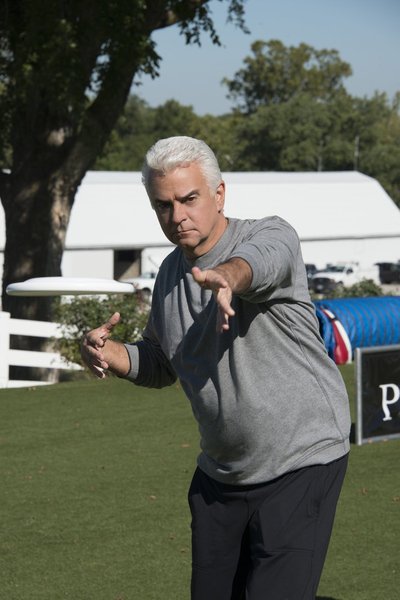 Great.
You have all kinds of dogs in the Ambassador Program this year. I
noticed that Vivian is a mixed breed dog, right?
Great.
You have all kinds of dogs in the Ambassador Program this year. I
noticed that Vivian is a mixed breed dog, right?
David Frei:
Vivian
came to us because of her wonderful work at Penn Vet – the
University of Pennsylvania Vet School – and as a therapy dog,
visiting at the Ronald McDonald House in Philadelphia, where we had
our opening press conference this year. Yes, she is a mixed breed
dog. She’s got Bull Terrier and Boston Terrier, I think. But,
Michelle Pich, who is a veterinarian at Penn Vet, actually wrote the
Penn Vet program, I believe. They take dogs around the different
healthcare facilities. We’re honored to have her be part of what we
do.
There’s so
many breeds in the show, and you guys are obviously both big dog
guys. I was wondering what breeds do you two live with? I think that
John had mentioned he had at least one Maltese.
John O’Hurley:
I’ll
answer first, David. The Maltese, sadly, has passed away.
I’m sorry.
John O’Hurley:
No,
that’s all right. She lived a full life. She was nearly 21 years
old. That’s about as old as a dog can get. But, we have a Cavalier
King Charles, a five year-old named Sadie. Then we have a five
year-old Havanese. Lucy is our little Havanese. The Cavalier is a
cousin to one of David’s dogs.
David Frei:
We
have the same breeder – Patty Cannon, in San Ysidro, California –
who brought us our Cavaliers – my Cavalier, Angel. I have a Brittany
named Grace, who are each the greatest dogs of their breed, of
course. Before that I had two senior Brittanies that have each
passed, but who did a lot of pioneering work as therapy dogs in New
York City. Got us into a lot of places where dogs have never been
before.
But my original
breed in the dog show world was Afghan Hound. I raised and bred and
trained and showed Afghan Hounds for thirty-something years. I never
had a dog growing up, so my Afghan Hound and the jump into the show
world was my first real experience with dogs.
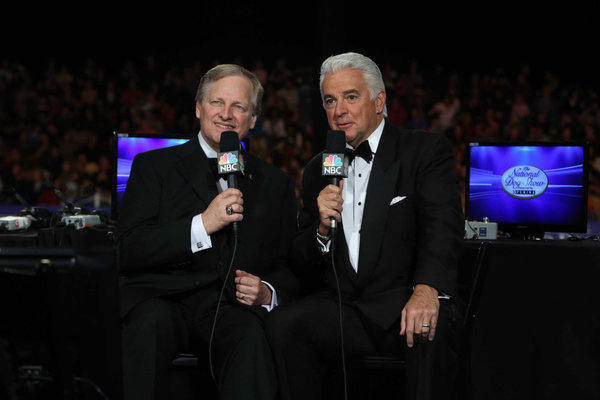 That’s
terrific. As a native Philadelphian, we’re very proud of the dog
show. How involved has the community been in the show and do you
also get time to see any of our city?
That’s
terrific. As a native Philadelphian, we’re very proud of the dog
show. How involved has the community been in the show and do you
also get time to see any of our city?
John O’Hurley:
Well,
I’ve been there quite a bit. I hung in an extra day to go downtown
there to spend a little more time in the historic area. Actually
staying at the Morris House. Had a great time down there. What a
spectacular area.
I’d like to say
that I felt it more this year – the enormous outpouring of the
community in terms of actually showing up to the Expo Center. I
don’t think I’ve ever seen as many people. We had standing room only
for the entire show in the ring, which meant the group competitions
and best in show. I don’t think I’ve ever seen as many vendors
there; they were in areas of the arena that I have never seen before
and set up booths. I think we had, certainly, the largest collection
of people there that I’ve ever seen, and could not have been more
enthusiastic.
David Frei:
The
gate was up 20% on Saturday, thanks to the hard work of Steve
Griffith and the Kennel Club of Philadelphia people. So, that was a
great thing. There were more vendors, you’re right, John. There were
more vendors than there were before. The community in Philadelphia
is very supportive of it. We did our press conference there two
weeks before the show at the Ronald McDonald house in Philadelphia
and got a great response from the local media, which obviously
helped feed that gate. We think there’s great support there for this
show itself and for dogs in general. We’re just thrilled to be a
part of it.
John O’Hurley:
I
think too that as the history of the show has gone on and it’s
become, not only a Thanksgiving tradition, but a Philadelphia trend
and it’s a wonderful thing. It’s a wonderful banner for the
Philadelphia area to be able to wave, because this is the world
watching. This airs all over the world and it is exponentially the
largest-viewed dog show in the world.
David Frei:
Media-wise, even the sports people get involved. I did a column with
a sports columnist from The Philadelphia Inquirer, with whom
I compared different breeds with the different players on the Eagles
team. We had great fun with saying: this guy’s an Afghan Hound, this
guy’s like a Rottweiler, this guy’s like a Doberman, this guy’s like
a Whippet. In the sports pages, we don’t always get a lot of
coverage from the sports pages because they’re not sure if we’re a
sport or not. We all think that we are, but to have that kind of
attention and respect from the local media is also a big part of the
success of what’s gone on there.
Can you both
just tell us a little bit about some of the new breeds that are
going to be in the show this year?
David Frei:
Sure,
three new breeds. Do you want to take a shot, John, at any of them?
John O’Hurley:
No,
you go ahead.
David Frei:
Okay.
Three new breeds this year gives us a total of 190 breeds and
varieties. They have one in a working group called the Chinook –
which is actually a sled dog that originated in this country, and is
actually the state dog of New Hampshire. It’s a beautiful, large,
working dog. Looks great.
We have a new
terrier this year – the Rat Terrier – called that, not because of
how it looks, but because of what its original function was, and
that is as a ratter on the farm.
John O’Hurley:
Actually, a beautiful breed, too. I think the name, kind of, steers
you in the wrong direction. It’s a really beautiful dog.
David Frei:
It is
a pretty dog, with erect ears and a nice solid terrier. Very
terrier-like, of course, in its personality. Then, the new hound –
the third of our three new breeds – is the Portuguese Podengo
Pequeno. That’s a little rabbit-hunting dog from Portugal, that has
a little bit of terrier added to it. But it also is a hunting dog, a
champ hound, kind of short, but it also uses its sight to hunt. [It]
comes in two varieties – either wire coat or smooth. A fun little
dog. It was fun to see them. You’ll see all three of them on our
show in Thanksgiving Day.
I recently
read an article by Stanley Coren on the fact that some of the breeds
are becoming extinct. I don’t know if you caught that article in
Psychology Today, the numbers are dwindling in some of
these purebreds the more the Doodles are gaining in popularity in
these other breeds. He mentioned Corgis and Dachshunds, and I was
surprised to see some breeds that I’m very familiar with. I was
wondering if you saw the article, or you have any thoughts on that?
Are there certain numbers that are going down and others that are
going up?
David Frei:
I did
see the article, and I have spoken to my friend Betsy Conway with
Otterhounds, because that’s one of the breeds affected. They had
less than 400 dogs, they say, in this country and less than 800
world-wide. As long as there are people around like Betsy Conway,
and others who have devoted their lives to these dogs, I think
they’re all going to survive. There may not be huge numbers of them,
but there are a lot of breeds around the world that don’t have huge
numbers.
John O’Hurley:
I’m
just going to add – sorry to interrupt you, but I think it
underscores the importance of a show like this and also the
visibility of a show like this. Not only does it engage the country
with 175 plus breeds that they don’t normally see, but it also gives
the opportunity for the people that are there, in person, to have an
opportunity to be interactive with these breeders. So, you may find
a dog that you wouldn’t ordinarily know, and sadly, most of us, most
people grow up with a working knowledge of maybe five breeds. That’s
about it, because you them in the neighborhood. It underscores the
importance of the dog show world.
David Frei:
A
factor in this is, of course, is just a pretty basic thing – and
that is that we originally were breeding dogs and creating new
breeds to do specific jobs for people. Now, because of the
Industrial Revolution, or whatever, dogs aren’t needed to do those
jobs anymore. We don’t need a Rottweiler to drive cattle to market.
We don’t need Afghan Hounds to hunt snow leopards. But, the things
that gives them the personality and the temperament to do those jobs
is still inherent in them. People like that and they breed these
dogs now for companionship. They still have the innate ability to do
it.
My Brittany,
Grace, has lived in a high-rise in Manhattan since she was seven
weeks old. She’s never been in a bird field to point at pheasants,
but she’ll point every pigeon she sees walking down the sidewalk in
New York City. She still has it. She’s still wired to do that.
David, you’re
absolutely correct about John, you know, being the silver fox that’s
got way more than his fair share of hair. But, I love that Swiss-dot
bowtie you had on with your tux. I thought that was wonderful.
David Frei:
Thank
you. Be sure to tell P. Diddy that because that was a Sean John
bowtie.
When people
watch the shows on TV or go to the show, everyone gets attracted to
the rings; but when you walk around the Expo Center, besides that,
you’ve got the benching area. You’ve got the fly ball and the disc
dogs and of course Purina has got all kinds of great demonstrations
going on. Could you talk just a little bit about some of those other
things that people can see when they come to a dog show?
David Frei:
John,
why don’t you talk to her about the benching?
John O’Hurley:
I
would say that if not for the fact that we were able to walk up and
down the aisles every year, I don’t know that we would have a
Cavalier King Charles Spaniel in our home. I don’t know that we
would have ever been introduced to the Havanese breed. It was really
to the interaction. I think it’s one of the most attractive elements
of the show for everybody that comes in, being able to walk and up
and down these aisles, and see each of the breeds and talk to the
owners.
It isn’t just the
cuteness factor; there’s a big wow factor in there as well. The fact
that some of these dogs, as popular as they are, are also just great
family dogs. You start to pick a breed, when you’re looking for a
dog that’s the best place to go because you learn so much.
Yes, it does go
back to the other idea that it really has a wonderful carnival
atmosphere backstage and something for everybody back there. We have
vendors that are selling. There are so many wonderful education
programs, both from the standpoint of nutrition, from exercise, and
for just health and wellness, that Purina does so much for. There’s
so many ways to learn more about the dogs and also, perhaps, find a
dog that is peculiar to whatever your life is like.
David Frei:
As to
your other question about the other activities too, first of all,
that’s part of the educational process of going to a dog show. Being
able to talk to the breeders and owners and handlers of certain
breeds back in the benching area. I think there was an agility
demonstration there. There’s the incredible dog challenge that
Carson International people stage in other parts of the country all
during the year, but they’re part of the show as well. There’s
obedience going on. You can keep moving around and see something
that’s different every step of the way. That’s the great thing about
coming to the dog show in person and you’ll see some of that in our
telecasts.
John, you had
touched on the competition of the dogs being with a breed standard.
That’s what they’re actually competing for. People at home might be
sitting there thinking, “I don’t know why that one won, that one
looks better than that one.” But they’re not really competing
against each other, per se, are they?
John O’Hurley:
No,
that’s a very good point. It’s something that we try to explain to
our viewing audience every year, that it isn’t the cuteness factor.
As David has said time and time again – you really have to be a
judge with a working database of all of the breeds that are
represented in this group. You have to have the knowledge of what
that specification is for each dog. So, it’s an enormous onus on the
back of each of the judges, and hats off to them for really being
able to absorb all of the information because you’re talking, in
many cases, 30 plus dogs in a group. That’s an awful lot to know
about any one specific breed because they’re all so different. But
you’re right, they’re basically competing against themselves. Until
you get your hands on the dog – as David says – you really don’t
know what’s in there.
David Frei:
But even us in the dog show world, walking around at that dog show –
we’ll stand outside the ring and we’ll look at what’s going on too.
See what a judge does and say, “Well, how did he pick that dog? Why
didn’t he pick this other dog?” It’s the same as people sitting at
home watching on television. They can pick whatever dog they want
for whatever reason they want. They’re cute. They did something
cute. They like their hairstyle. They like their attitude. They like
that they did something cute with somebody in the crowd. Pick the
winner you want, and then reach over and hug your own dog. Again,
the real best in show dog is right there with you, as John and I
both say constantly.
David, you
were speaking earlier about the extinction – the article that came
out. Can you talk a little bit about some of the criteria that is
introduced by the AKC [American Kennel Club] for a new breed to be
introduced? Not only that, but is it possible, once they have
maintained certain levels to be introduced, can they be – I don’t
want to say disqualified, but excluded – from the register if they
drop below a certain number?
David Frei:
Well,
first of all, we use the expression “new breeds.” We say “new
breeds” all the time, and they really aren’t new breeds. Most of
these dogs have been around for a lot of years – hundreds of years,
even. They just haven’t had the kind of following in our country,
both in terms of numbers – they need a certain number, a certain
population in this country. They need to have a geographic
distribution. They can’t all be sitting on a ranch somewhere down in
Texas. They need to have a parent club that’s watching out for them,
like the Chinook Club of America, that makes sure the dogs are
breeding true to their studbook and things like that.
Once they’re in –
I mean, we have 190 breeds and varieties now, but there’s probably
something like nearly 400 recognizable breeds worldwide. They just
don’t have that kind of numbers of following in the US that gets
them recognized by the American Kennel Club, and then eligible to
compete in a show like the Kennel Club of Philadelphia, which is the
National Dog Show.
As far as
dropping out, we haven’t had any dropouts in the time that I’ve
known. I’ve been doing Westminster, now, since 1990. When I first
came in we had 142 breeds and varieties, and now we have 190. That’s
25 years later, so about two breeds a year is the average, I guess.
We seem to be getting a lot more, lately.
John, you and
David and Mary [Carillo] have got such a great chemistry together,
and have worked together the last few years. Have you ever had what
I’d like to call a “Seinfeld
moment”? Everybody has seen the outtakes in Seinfeld where
you have to hit the mute button, and one of you has to hurry up and
get it together before the commercial’s over?
David Frei:
(laughs)
No, we’ve never
had a moment like that. We’re a well-oiled machine.
John O’Hurley:
I was
going to use the word “seamless.”
David Frei:
We
have a lot of fun doing the show. Yes, every once in a while, we’ll
all start laughing or smiling at the same time where it does become
one of those moments, but only, of course, in great fun; because who
doesn’t look at a dog and smile? That’s what this is all about. A
dog will do something cute and we’ll all get excited about it, or
somebody – usually John – will say something quite funny, and it
will crack up all of us. We have a great time doing the show. John
and I have been together twelve years. I know people out there who
have marriages that don’t last that long.